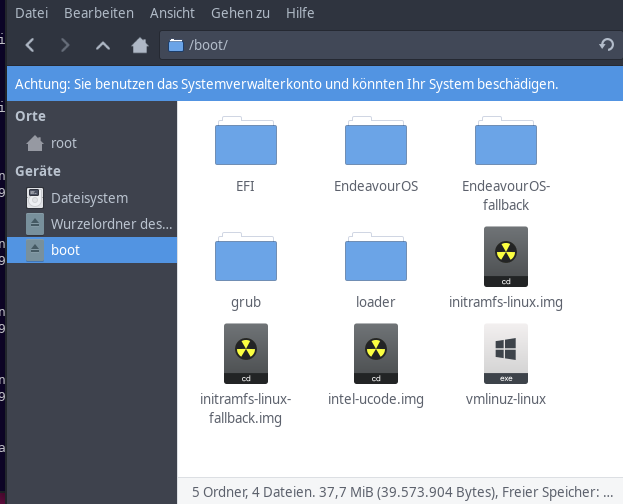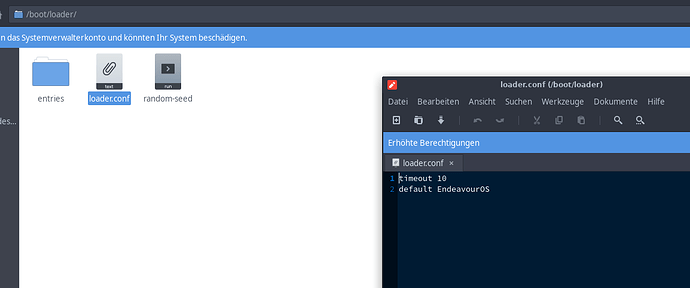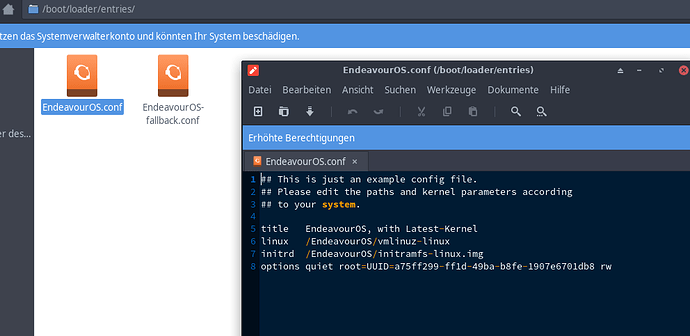Simple in both senses is rEFInd - not complicated AND easy to set up. Also handles multi-boots better than any alternatives I’ve found…
i like it that my bug threads cleanup brings such interesting informations to my attention 
is it possible to configure rEFInd to show description for boot entries? i do just start with it and i do see only icons used in the themes i try, what is not very informative if you have a triple boot with all endeavouros, and it shows only a lot eos icons to boot from…
There are other options for choosing icons - for an example see the wiki (user contrib) pic - ALL EnOS, all different!
One of the easiest means is to copy an appropriate .png file into /boot as vmlinuz-linux.png
Also - the label of the partition you are booting from shows under the icon when selected… (I always label when I can, saves confusion! as well as showing up better in your filemanager…)
Easy and complex aren’t always opposites. Something can be both easy and complex at the same time. I wasn’t using the word complex as the opposite of easy. This is one of those times where semantics are important and one word having multiple meanings makes the conversation…complex. ![]()
I triple boot and I have changed the icons for rEFInd. 
Edit: Is all EOS too!
You can control the ui by configuring the hideui setting in the theme.conf:
# Hide user interface elements for personal preference or to increase
# security:
# banner - the rEFInd title banner (built-in or loaded via "banner")
# label - boot option text label in the menu
# singleuser - remove the submenu options to boot Mac OS X in single-user
# or verbose modes; affects ONLY MacOS X
# safemode - remove the submenu option to boot Mac OS X in "safe mode"
# hwtest - the submenu option to run Apple's hardware test
# arrows - scroll arrows on the OS selection tag line
# hints - brief command summary in the menu
# editor - the options editor (+, F2, or Insert on boot options menu)
# all - all of the above
# Default is none of these (all elements active)
#
hideui singleuser,hints,arrows,label,badges
hints shows a command summary (like ‘Hit F2 …’), and label shows a small description (like Boot vmlinuz… from …). So by activating labels you should see some info on the current boot entry.
I know @freebird54 is more the expert than i’ll ever be but he gave the hint before and i boot mine with the grub_64.efi. So on triple boot i put another folder in with EndeavourOS called EnOSp for plasma and EnOSc for Cinnamon and inside i put a copy of the grub_64.efi from the EndeavourOS folder. Then i put the icons in the rEFInd Icon folder with same proper naming os_EnOSp.png.
EndeavourOS folder and EnOSp folder is in /boot/efi/EFI/
Same with EnOSc
I can also boot it the other way using the vmlinuz-linux image instead of grub.
Calamares-based installs use GRUB, I think. Other installers that I have tried out give you the option. I always use the SystemD-boot when I do a ‘vanilla’ Arch install because I understand it now and I can do it in a flash. But then, I don’t need to do multi-boots for additional OS installations. Just for fun, I tend to use the newish Calam-Installer when I do a quick base install on Virtualbox and that is a GRUB-based boot. I believe that Calamares is still having difficulties from time to time with the Disk Partitioning (if you do a manual partition, the install fails) and in the past EndeavourOS have always recommended doing your own disk partitioning with GParted (cfdisk for me) before letting Calamares loose on your hard drive.
for some days i do tinker with @ringo on systemd-boot for calamares, and it can take it, but uses a strange way to install it, you can choose /boot or /efi or other mountpoint, for the ESP (fat32 partition to mount it to) to install with systemd-boot, but then you are on your own to create a script/hook to handle kernel changes… systemd-boot
seems not to have any automatic implementation to handle this… and calamares will not be able to handle dualboot with this.
Using grub as the loader on top of EFI itself is working without any issue on kernel changes and dualboots…
I think that modern versions of systemd can handle this via kernel-install. Take a look at this:
https://aur.archlinux.org/packages/kernel-install-hook/
I would be glad to help test this if you like. I have quite a bit of experience with systemd-boot and I built a tool for Manjaro to manage systemd-boot since Manjaro has changing kernel names it is a bit trickier.
Currently there’s no common boot scheme across architectures and platforms for open-source operating systems. There’s also little cooperation between multiple distributions in dual-boot (or triple, … multi-boot) setups. We’d like to improve this situation by getting everybody to commit to a single boot configuration format that is based on drop-in files, and thus is robust, simple, works without rewriting configuration files and is free of namespace clashes.
exactly what I do experience on my testings ![]()
I could create a systemd-boot enabled calamares version to start with that?
This option is not included as an optional chooser inside install question you only can set it to be used per default for efi systems.
Would be more cool as optional choosable…
This is the structure Calamares installs if I configure ESP as /boot

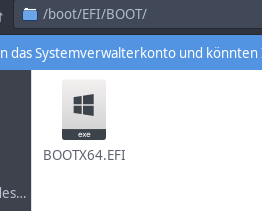
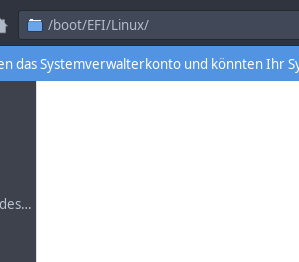

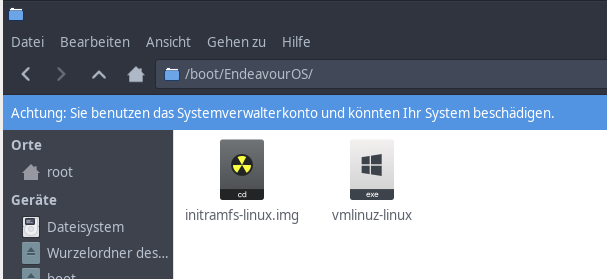
Are there two copies of the kernel? One in /boot and one in /boot/EndeavourOS or are those symlinks?
If I could get a version to test with that would be a good start.
no symlinks there are real copies ![]() (one of the strange thing i see)
(one of the strange thing i see)
i will do this now.
Personal i dont get it since the kernels get installed in /boot but i think also get confuse about 
if you want the modules into /then python brakes it of /set too /boot/ or whatever but it names to endeavouros at the end;; even you change or calamares wil use the standard config for it somewhere
didnt configure sd-boot not that way but stil 
Just because, I installed my vanilla Arch install I did two weeks ago with /efi instead of /boot/efi just because.
(Honestly mostly because if I have to ask a question on an actual Arch forum or Reddit no “I use Arch btw” person will claim I “didn’t follow recommendations”.)
Is because of this? ![]()
“Yes. Because /boot/efi is just stupid, as it implies that an ESP partition implies a separate /boot partition, but that’s nonsense.”
Edit: I use /boot/efi … but i don’t know any better. ![]()
Keep in mind. That excerpt is from bootctl(systemd-boot) and not a general comment. In the case of systemd-boot, using /boot/efi makes far less sense than with grub since for systemd-boot the kernels and initramfs reside in the esp.
I understand …it just made me laugh! 
